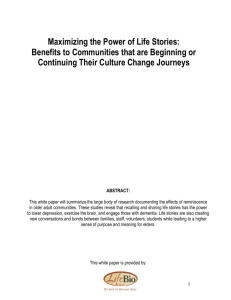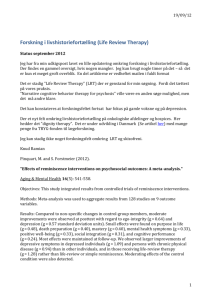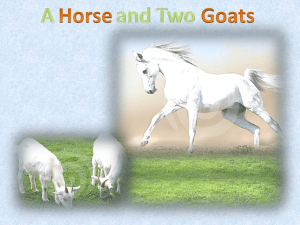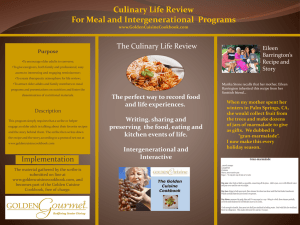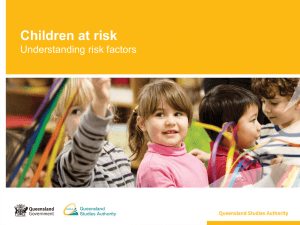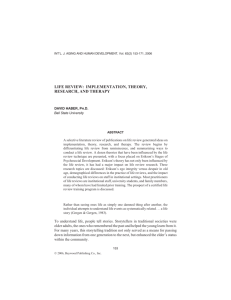1 apprentice as a group leader
advertisement
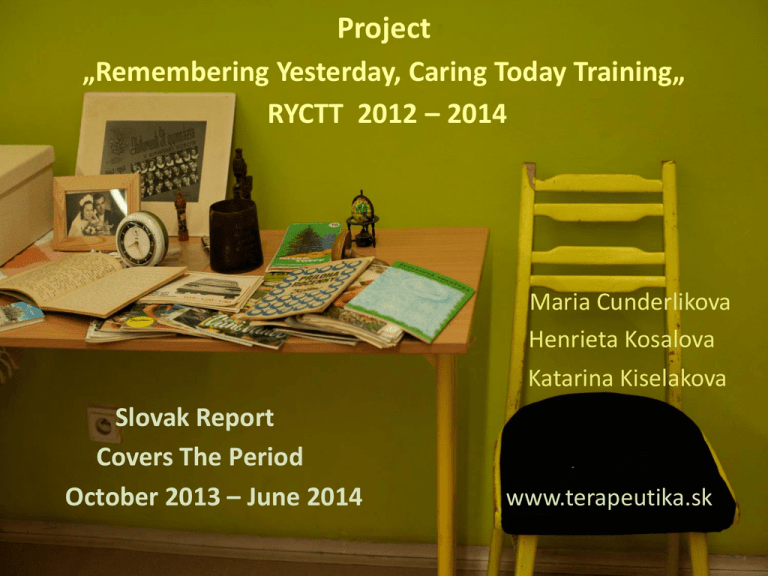
Project „Remembering Yesterday, Caring Today Training„ RYCTT 2012 – 2014 Maria Cunderlikova Henrieta Kosalova Katarina Kiselakova Slovak Report Covers The Period October 2013 – June 2014 www.terapeutika.sk Participants of the Training Programme in Bratislava We trained 17 participants from several regions of Slovakia. They were of various background: social senior care staff, curative pedagogues, psychologists, social workers, an art therapist, a physiotherapist, a family member. 8 participants followed with the training and lead 5 different reminiscence groups 1. group: „Charitas“ senior home care in Bratislava Reminiscence sessions: 6 / once a week Elderly/ family carers: 4 people with dementia / 5 family carers Teamwork: 1 apprentice as a group leader, 1 assistant (employee of the senior home) and 1 volunteering photographer End-products: Family tree collages 8 participants followed with the training and lead 5 different reminiscence groups 2. group: Social services home in Bratislava „Dom tretieho veku“ Reminiscence sessions: 7 / once a week Elderly/ family carers: 5 people with dementia / 12 family carers Teamwork: 1 apprentice as a group leader, 1 apprentice – assistant (employee of the home), 1 assistant (employee of the home) as a photographer and 1 apprentice – director of the home End-products: photo albums, memory boxes and a tableau of photos from each session 8 participants followed with the training and lead 5 different reminiscence groups 3. group: „Dominik“, non-profit organization, residential home for seniors in Velka Lehota Reminiscence sessions: 9 / once a week Elderly/ family carers: 32 people with dementia / 0 family carers Teamwork: 1 apprentice as a group leader and 1 apprentice - director of the home who made a video End-products: video record and a product from each session 8 participants followed with the training and lead 5 different reminiscence groups 4. group: Residential home for seniors in Senica (a small town near Bratislava). Reminiscence sessions: 3 / once a week - not completed due to organizational changes Elderly/ family carers: 8 people with dementia / 10 family carers Teamwork: 1 apprentice as a group leader and 1 assistant (employee of the home) as a photographer End-product: none 8 participants followed with the training and lead 5 different reminiscence groups 5. Individual group: Home/ Bratislava Reminiscence sessions: 10 / once a week Elderly/ family carers: 1 senior / 1 family carer (trained) Teamwork: 1 apprentice as a group leader – a family carer who also took pictures End-product: Reminiscence artefact (a model of a bicycle with a collage made of photographs in it) Background of running reminiscence groups before the start 1. Organisational and technical consent with the directors of residential homes One group announced collection of reminiscence objects and then they could prepare the reminiscence room. 2. Reaching out to seniors Each group started via personal invitation in their residential homes. Then they would hand seniors a printed invitation with the next topic of reminiscence before each session. 3. Reaching out to the families Each group started through the phone and with personal invitations but many respondents did not want to cooperate. In another groups, it was very important for the families who promised to participate to make the first appointment without their seniors. There they would get all the information about reminiscence: how to communicate with them, why it is important to make connections through memories etc. 4. Planning the sessions Each apprentice created their own plan during the training programme already. That means each plan, eg creation of the environment, topic for each session, teamwork, the structure of each session, group leading by apprentice as a leader, etc. had been consulted during the training with us. So apprentices were instructed and ready before beginning. Background of running reminiscence groups during the course 1. Examination/assessment of trainees Trainees (apprentices) gave us feedback via e-mail, through the phone and during the our personal visits on some reminiscence sessions. In one case apprentice could provide feedback by the video report from each session. After that, on our initiative, they sent us summary information about how they run reminiscence sessions. 2. Reaching of the suggested outline of sessions In three cases apprentices followed what they planned and consulted outline (they used project´s suggested criteria). In individual reminiscence work apprentices had to adapt to seniors’ changing needs (eg. selection of topics, timing etc.). In the case of the last group, apprentices continued in reminiscence session so they didn't follow suggested topics. They sometimes had a problem with a precise defining of topics. If they defined one too specifically, they would get many different contexts from the seniors. They spoke about different things what broke the connections in conversation. 3. Achievement of creating end-products End-products were created in 4 groups. Background of reminiscence groups after sessions 1. Final meeting of the apprentices from all reminiscence groups We organized the final meeting on March 1, 2014 where each apprentice as leader of the reminiscence group presented the PowerPoint contribution about the reminiscence experiences with end-products. 2. Handing over the certificates At this meeting we gave everyone the certificate from the project after the presentation. We handed over 8 certificates. 3. Preparing the bulletin about Slovak reminiscence work of RYCTT project We are already preparing the bulletin where we will include contributions with the photos from the apprentices, too. Our recommendations for the future 1. Promote personal creativity We think there should be space for creative work with materials during the training program. That could help to discover self creativity in each apprentice. The creativity is important for bringing new ideas in end-reminiscence products. 2. Communication training for the apprentice as a group leader Apprentices asked this question: "How should I respond when a client gets angry or starts to cry during the rememberance?“ Therefore we consider the communication training necessary and should be implemented in the training, too. 3. Group dynamics training „How to manage connections between seniors and between senior and family carers?“ That was another question from apprentices. 4. Organizing a meeting before running reminiscence for family carers only It is a good way how to motivate family carers to cooperate. It is also important to give them in advance all the necessary information about what is reminiscence, why it is important and how to cooperate and communicate with seniors during meetings. Thank you for your attention and we wish you lots of success at continuing with the Reminiscence Work www.terapeutika.sk
